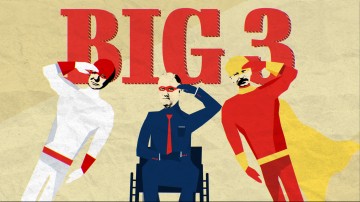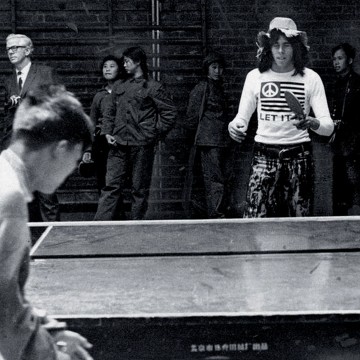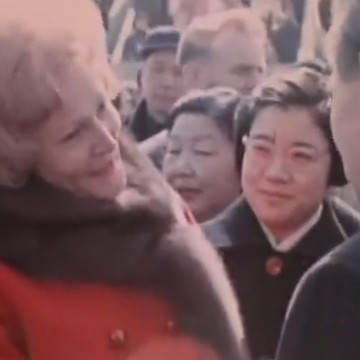From Yalta
to Malta
This historical explainer series covers the events that have shaped our world, how the U.S. has played a pivotal role in framing this ongoing trajectory, and unpacks the vital connections between the past and the present.
By VOA Program Acquisition & Commissioning
June 2023
With Nazi Germany backed into a corner, the end of the second World War is finally in sight. But what will liberated Europe look like? Can Stalin be trusted? And will America’s new superweapon be needed to end the conflict with Japan? Episode 1: The Last World War
It’s the 1940s, and millions of people have perished in World War II. Hopeful to end the war quickly, the United States, Great Britain, and the Soviet Union (USSR) have worked together in an alliance. Episode 1 looks at the interactions between these nations’ leaders as the last world war comes to an end. You'll also learn how one bomb test changed everything.
U.S. President Franklin D. Roosevelt, UK Prime Minister Winston Churchill, and the USSR’s leader, Josef Stalin, meet to discuss strategy in early 1945. This is known as the Yalta Conference. The heads of state and their entourages stay in abandoned palaces with bed bugs, lice and only 9 working toilets. They discuss Japan, Poland, and the Nazis.
Can you guess who made fun of whom? And who was grateful for the whisky?
Can you guess who made fun of whom? And who was grateful for the whisky?

A picture from an animation of WWII allied leaders.
Roosevelt returns home, optimistic about the alliance with Stalin and Churchill. But soon after the conference, he dies, and the delicate relationship is now in the hands of his vice president, Harry S. Truman.
When Truman becomes president of America, he learns that Roosevelt had started a secret atomic bomb program called the Manhattan Project.
After Germany was defeated in 1945, Stalin and Churchill meet up in Potsdam, Germany, this time with Truman instead of Roosevelt. The leaders celebrate their defeat of the Nazis with champagne. Truman receives a message from his military about the first successful atomic bomb test. He shares a few details with Stalin, who already knows about it. How did Stalin know about the weapon, and how did he react?
The U.S. attacks Hiroshima and Nagasaki, Japan with atomic bombs in 1945. Japan’s Emperor Hirohito surrenders soon after. Then the Soviet Union begins developing its own bombs.
Watch Episode 2 to learn how U.S. President John F. Kenney (JFK) and Soviet First Secretary Nikita Khruschev interact in the Cuban missile crisis. And, while Cold War nations race to build nuclear weaponry, people worldwide grow fearful of the destruction of humankind.
Things continue to heat up between the Soviet Union and the USA. With missiles pointed at both nations, nuclear war seems to be only a button’s press away. But who will be the first to press it? Episode 2: M.A.D.
John F. Kennedy and Nikita Khrushchev pose at the Vienna Summit.
It’s the 1960s, and people around the world are scared. Not about the Space Race but a nuclear arms race between the Unites States of America and the Soviet Union.
During the Cuban missile crisis, all eyes are on Russian premier Nikita Khrushchev, Cuban premiere Fidel Castro and American president John F. Kennedy. Their militaries prepare for war in the Caribbean, but no one launches an attack. Why? The answer is "mutually assured destruction," a.k.a. MAD.
Here’s some background context. Kennedy won the presidential election in 1960, promising the American people he would fix a missile gap with the Soviet military. Months into his presidency, he met Khrushchev at the Vienna Summit in June 1961. During their meetings, Kennedy said something that may have emboldened the Russian leader and changed history.
Now, in 1962, Soviet ships are sailing toward its Communist ally nation, Cuba. The vessels carry nuclear weapons. A Soviet missile launched from Cuba could destroy the American capital, Washington, DC. and Kennedy has to react. His advisors are divided into two groups: "hawks," who think he should use military action, and "doves," who believe he should use diplomacy.
On “Black Saturday,” October 27, 1962, the USSR, U.S. and Cuba have a military standoff. Leaders wait hours for their time-sensitive messages to reach each other. For the first and only time in U.S. history, DEFCON 2, an advanced readiness for war, is called. Millions of people around the world fear a nuclear war.
In the middle of the crisis, Khrushchev writes a cable to Kennedy, saying that the USSR would remove all its missiles from Cuba, if the U.S. agrees not to attack the Caribbean Island and to remove its missiles in Turkey. What is Kennedy’s reply?
Watch episode three to find out how China and American relations warm up after an accident involving a confused ping pong player.
When an American surveillance plane is shot down over Cuba on October 27, Kennedy's advisor, Curtis LeMay, says, "I just don't see any other solution except direct military intervention, right now!" But Kennedy ultimately chooses a diplomatic option. Watch this episode to see how the conflict eventually ended.
Political dynamics change after Kennedy is assassinated in 1963 and Khrushchev is removed from office in 1964. New Cold War leaders would pick up where their predecessors left off. Their focus would shift from Cuba to Vietnam. And China’s nuclear power would change everything.
A new nuclear power emerges which threatens to disrupt the delicate political balance. But a chance interaction and an unlikely friendship gives the world some hope. Can peace be achieved? Episode 3: The Little Ball
Mao Zedong and Richard Nixon shake hands.
During the Cold War, in the beginning of the 1970s, the relationship between the United States and the People’s Republic of China wasn’t great. China had developed nuclear weapons, adding more power on the communist side of the war. That alignment worsened fears of communism in America.
But then, a confused ping pong player, looking for his table tennis team started a domino effect of diplomacy. The development of economic and diplomatic relationships between China and the U.S. surprised many people at that time.
The story starts in Nagoya, Japan at the 1971 World Table Tennis Championship. American player Glenn Cowan misses his bus and accidentally boards one with China’s national team.
Chinese champion, Zhuang Zedong greets Cowan and offers him a silk painting. A photo of them smiling in a parking lot makes headlines. Shortly after, Mao and his advisor Zho Enlai invite the entire U.S. table tennis team to China on a friendly tour, opening the door for communication.

Glenn Cowan playing table tennis in China.
A surprising new relationship between China and America developed.
Television cameras follow First Lady Pat Nixon, giving Americans a glimpse inside the secluded Asian country. Chinese officials invite Mrs. Nixon to see things like acupuncture, a panda, and the Great Wall of China. Diplomatic advisors dress the first lady in bright red coat, a symbol of prosperity in China.

Pat Nixon being greeted in China in a bright red coat.
President Nixon meets with Chairman Mao Zedong, symbolizing the new diplomatic relationship.
But diplomacy efforts would change when Nixon resigned in 1974 and Mao passed in 1976. The Cold War heats up again with new leadership in episode 4.
After a period of relative peace, new leaders and new weapons seek to bring balance to the force. But can they truly end the Cold War? Episode 4: Star Wars
Ronald Reagan and Mikael Gorbachev smiling at the Geneva Summit in 1985.
By the 1980s, the Cold War between the United States and the Soviet Union has been going on for decades without direct violence between the two superpowers. Both countries have built up their nuclear arsenals. Several missteps and miscommunications nearly set off retaliatory strikes. People across the world fear an escalation to nuclear war.
President Ronald Reagan meets Soviet General Secretary Mikael Gorbachev at the Geneva Summit in Switzerland in 1985. They discuss nuclear arms and their reduction. The two enjoy each other's company and share several similarities. Most importantly, they are both invested in reducing nuclear weapons.
If a nuclear conflict broke out, there could be enough dust to block the sun and freeze the planet.
The two leaders meet again in Iceland at the 1986 Reykjavik Summit. They try to agree on a plan to eliminate nuclear weapons.
How did Reagan’s Strategic Defense Initiative, also known as the Star Wars program, affect the discussion? And what are the results of the summit?
Watch Episode 5 to see how the Cold War ends.
A series of revolutions spark in the Eastern Bloc as young people begin to demand a voice. But will these movements be enough to topple the Iron Curtain? Episode 5: Fall of Nations
A machine removes a piece of the Berlin Wall.
Tensions between the United States and the Soviet Union—along with the size of their nuclear stockpiles—have been building for four decades. But a wave of revolutions in Eastern Europe in the late 1980s will lead to the end of the Cold War.
The Soviet Union’s new general secretary, Mikhail Gorbachev, takes office in 1985 with a whole new vision for the USSR. Glasnost, his policy of openness, allows people to criticize the government. His so-called Sinatra Doctrine lets Soviet-controlled republics start managing themselves.
Gorbachev hoped to form new bonds with America and Western Europe.
The Berlin Wall comes down after an East German official, Gunter Schabowski, announces at a press conference the relaxation of border restrictions. People celebrate in the streets, find friends and family who have been divided by the wall. Hand-held hammers and heavy machinery dismantle the concrete barriers. How does Gorbachev react?
Gorbachev and the newly elected U.S. President George H.W. Bush meet to resolve Cold War tensions at the 1989 Malta Summit. Fear of nuclear war has eased. Gorbachev hopes to form new bonds with America and Western Europe. But will he able to see this vision come to life?
Credits
Sr. Executive producer: Euna Lee
Executive Producer: Steve Redisch
Story Editor: Steve Redisch
Production Manager: Christina Cerqueira
Article Writer: Christina Cerqueira
Program Analyst: Tim Wright
Sr. Producer, Versioning: Mohamed Abdelkarim
Digital Visual News Editor: Yass Monem
Web Design/Development: Stephen Mekosh, Dino Beslagic
Production: Voyage Pictures